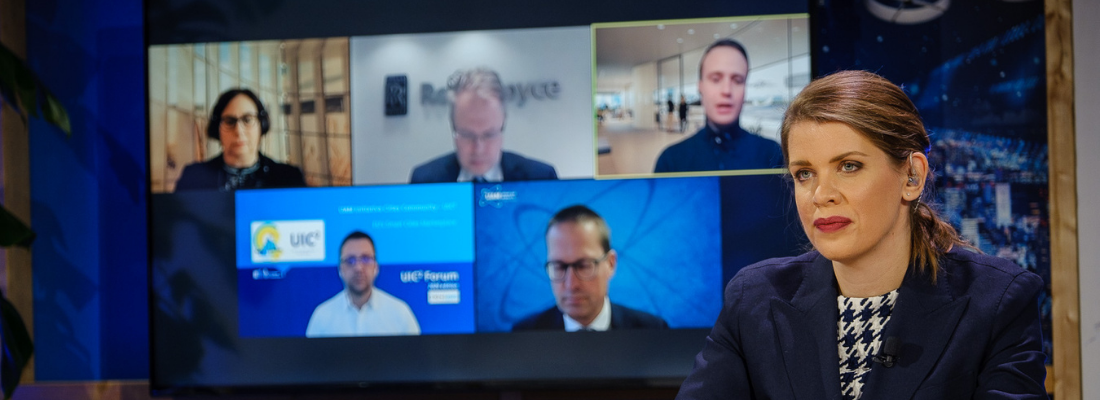What it takes to build the UAM ecosystem in Europe
During ADW Hybrid 2020 an important topic was building the UAM ecosystem. What is the view in Europe? We share some highlights from the panel discussion ‘What it takes to build the UAM ecosystem in Europe’.
Panel members: Vassilis Agouridas, Head of EU Public Co-Creation & Ecosystem Outreach at AIRBUS, Antoine Feral, Vice President EU Affairs at Rolls Royce/ASD Europe, Barbara Pareglio, Senior Director IoT at GSMA, Georg Rosenfeld, Head of the Department of Economic Development at City of Ingolstadt and Tassilo Wanner, VP Global Public & Regulatory Affairs at Lilium. Moderator: Tineke Bakker-van der Veen, CEO DragonFly Consultancy, former Managing Director of Boeing Northern Europe.
What is the role of cities in developing ecosystems for urban air mobility?
Mr Rosenfeld: “Well I think it’s rather simple. Cities are an ecosystem in itself. They provide the infrastructure for urban mobility to the extent that we add the air layer above the cities. With that mobility system, cities need to get involved with urban air mobility. It’s a very complex system, so we need to plan well in advance. Cities work for the benefit of their citizens. They need to care for the well-being and that’s why they also have to communicate with their citizens.”
Following your announcement, that Germany will be one of Lilium’s first launch locations. What had been the reactions from stakeholders and the public on your announcement?
Mr Wanner: “It was quite overwhelming, a positive one actually. We had high hopes, but were even mind blown and surprised, by how positive it was. It was a very nice signal, also from an industry politics point of view. Lilium as a German, as a European project, announced a European location first. And also one that could potentially be cross-borders within the heart of Europe. But it actually broke global news. So we were very proud, and actually got confirmation from the transportation ministry of Dusseldorf, that they had only received positive responses.
It is actually for society and adding connectivity, that makes sense to people and is also environment friendly. Not only from an operational point of view, but also as we don’t have to build all that connecting infrastructure. It’s still a process, but I think we’re getting more and more there. People are getting excited about having that in their respective regions.”
What is your strategy and the roadmap of Ingolstadt?
Mr Rosenfeld: “First of all we are part of the UIC2 community. It started in 2018, and we have since then build up this urban air mobility initiative Ingolstadt network with more than 70 partners. On top of that network we have started to develop a strategic project portfolio. So we already finished, and work on projects which sort of focus on interesting and particular useful applications of this technology. Like just-in-time delivery of medical devices and medicine to local hospitals. Or an automated vegetation control by drones around railroad tracks.
At the moment we are planning a new railroad main station. It is a planning process which takes a couple of years. And we have already decided to include a vertiport. Just to get acquainted whit these planning processes. Of course it’s a different dimension, if you add urban air mobility. So that has been a focus and we worked a lot on talking and communicating with our citizenships. In the next step we’re now working on a flight zone which can be used for test flights. This will connect the Ingolstadt munching airport to this new main station. It will cover all sorts of urban contexts. It will cross a highway, a railroad track, it will cross industry sites in various urban settings. It will be around 17 kilometres long. This will be a good test site and we have an overwhelming number of start-ups interested. So this will be the strategy for the time ahead.”
What do you feel are the conditions of success, that have to be in place?
Mr Agouridas: “I would say, mainly for conditions, is the technology, the adoption, the commercialization, and the impact. First technology, what kind of technology are we going to use. It will depend on of course what kind of needs there are and what kind of machine we are going to work with. So we need really to focus on what kind of technology we can use for specific cases.
Secondly is the adoption. The adoption is about the social acceptance. Having some flying machine and having some noise around you.
The third challenge is the commercialization. It’s about what kind of business model, and we have been talking about platforms. We need to think, what kind of new business model we are going to use, and we have to invent everything, everything is new. The final challenge is about impact. We need to think about what the value proposal is at the end of the day. And what are the benefits for all the stakeholder and the suppliers of the value chain. So we need to think about these four challenges, and of course act together. The success will be in collaboration. We need to think about safety.”
Share your story with us
Do you have knowledge on current air solutions, potential innovations and vital regulations you would like to share with the UAS community? The Amsterdam Drone Week website and social media channels are a great platform to showcase your stories!
Please contact our Brand Marketing Manager Hilke de Vries.



